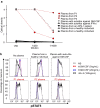Anti-GM-CSF Neutralizing Autoantibodies in Colombian Patients with Disseminated Cryptococcosis
- PMID: 36821021
- PMCID: PMC9947894
- DOI: 10.1007/s10875-023-01451-5
Anti-GM-CSF Neutralizing Autoantibodies in Colombian Patients with Disseminated Cryptococcosis
Abstract
Background: Cryptococcosis is a potentially life-threatening fungal disease caused by encapsulated yeasts of the genus Cryptococcus, mostly C. neoformans or C. gattii. Cryptococcal meningitis is the most frequent clinical manifestation in humans. Neutralizing autoantibodies (auto-Abs) against granulocyte-macrophage colony-stimulating factor (GM-CSF) have recently been discovered in otherwise healthy adult patients with cryptococcal meningitis, mostly caused by C. gattii. We hypothesized that three Colombian patients with cryptococcal meningitis caused by C. neoformans in two of them would carry high plasma levels of neutralizing auto-Abs against GM-CSF.
Methods: We reviewed medical and laboratory records, performed immunological evaluations, and tested for anti-cytokine auto-Abs three previously healthy HIV-negative adults with disseminated cryptococcosis.
Results: Peripheral blood leukocyte subset levels and serum immunoglobulin concentrations were within the normal ranges. We detected high levels of neutralizing auto-Abs against GM-CSF in the plasma of all three patients.
Conclusions: We report three Colombian patients with disseminated cryptococcosis associated with neutralizing auto-Abs against GM-CSF. Further studies should evaluate the genetic contribution to anti-GM-CSF autoantibody production and the role of the GM-CSF signaling pathway in the immune response to Cryptococcus spp.
Keywords: Cryptococcus gattii; Cryptococcus neoformans; Granulocyte–macrophage colony-stimulating factor; Meningitis; Pulmonary alveolar proteinosis (PAP).
© 2023. The Author(s).
Conflict of interest statement
The authors declare that they have no competing interests.
Figures


References
Publication types
MeSH terms
Substances
Grants and funding
LinkOut - more resources
Full Text Sources
Research Materials
Miscellaneous

